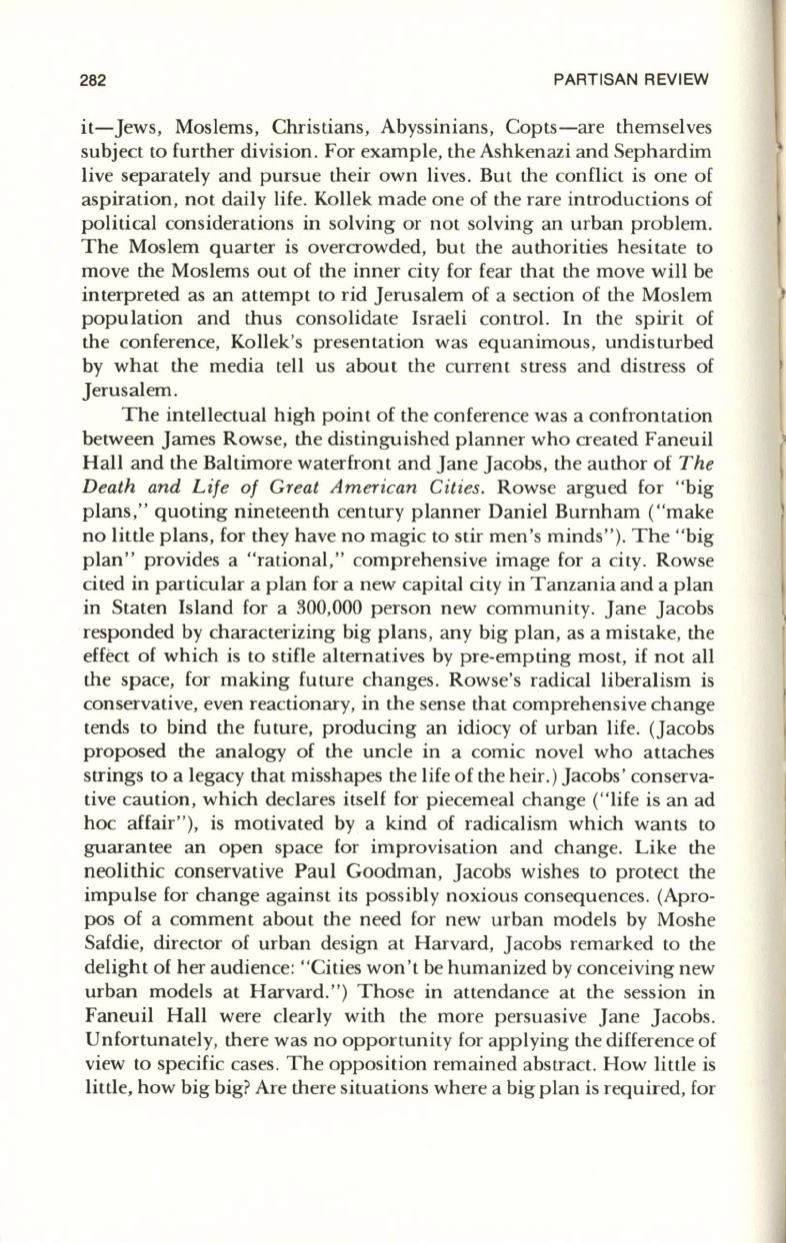
282
PARTISAN REVIEW
it-Jews, Moslems, Christians, Abyssinians, Copts-are themselves
subject to further division. For example, the Ashkenazi and Sephardim
live separately and pursue their own lives. But the conflict is one of
aspiration, not daily life. Kollek made one of the rare introductions of
political considerations in solving or not solving an urban problem.
The Moslem quarter is overcrowded, but the authorities hesitate to
move the Moslems out of the inner city for fear that the move will be
interpreted as an attempt to rid Jerusalem of a section of the Moslem
population and thus consolidate Israeli control. In the spirit of
the conference, Kollek's presentation was equanimous, undisturbed
by what the media tell us about the curnmt stress and distress of
Jerusalem.
The intellectual high point of the conference was a confrontation
between James Rowse, the distinguished planner who created Faneuil
Hall and the Baltimore waterfront and Jane Jacobs, the author of
The
Death and Life of Great American Cities.
Rowse argued for "big
plans," quoting nineteenth century planner Daniel Burnham ("make
no little plans, for they have no magic to stir men's minds"). The "big
plan" provides a "rational," comprehensive image for a city. Rowse
cited in particular a plan for a new capital city in Tanzania and a plan
in Staten Island for a 300,000 person new community. Jane Jacobs
responded by characterizing big plans, any big plan, as a mistake, the
effect of which is to stifle alternatives by pre-empting most, if not all
the space, for making future changes. Rowse's radical liberalism is
conservative, even reactionary, in the sense that comprehensive change
tends to bind the future, producing an idiocy of urban life. (Jacobs
proposed the analogy of the uncle in a comic novel who attaches
strings to a legacy that misshapes the life of the heir.) Jacobs ' conserva–
tive caution, which declares itself for piecemeal change ("life is an ad
hoc affair"), is motivated by a kind of radicalism which wants to
guarantee an open space for improvisation and change. Like the
neolithic conservative Paul Goodman, Jacobs wishes to protect the
impulse for change against its possibly noxious consequences. (Apro–
pos of a comment about the need for new urban models by Moshe
Safdie, director of urban design at Harvard, Jacobs remarked to the
delight of her audience: "Cities won't be humanized by conceiving new
urban models at Harvard. " ) Those in attendance at the session in
Faneuil Hall were clearly with the more persuasive Jane Jacobs.
Unfortunately, there was no opportunity for applying the difference of
view to specific cases. The opposition remained abstract. How little is
little, how big big? Are there situations where a big plan is required, for


